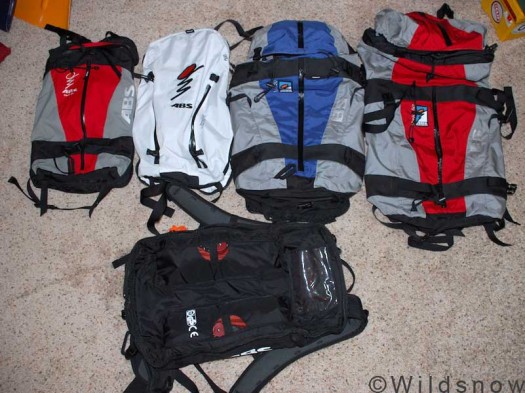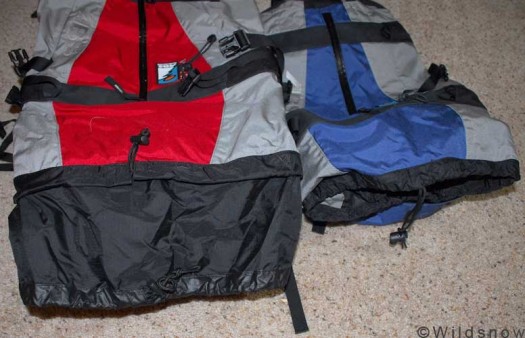I’ve been using the ABS Vario avalanche airbag backpack system for the last month and am stoked on the versatility and safety it offers. Like other airbag backpacks, the Vario uses compressed gas (nitrogen) to inflate a pair of air bags to keep you from being buried in an avalanche (for more on how this works, see my airbag overview). What is so cool about the Vario line is that you buy one base unit which can have different sized packs zipped on to it. So, for a short foray out the backcountry gate of the resort, you can zip on the 15 liter; for a mellow backcountry tour- the 18; for a big day in the backcountry- the 30; and for overnights and hut trips with bags and bags of wine, bring out the 50 liter monster. The last few years I’ve been using an older ABS pack (the Escape 50), with a fixed size of 50 liters, which was way overkill for ninety percent of my skiing, but allowed me to have it on overnights. Now, with the Vario, you can be flexible and not have to buy multiple pricey packs.

For all those lusting to pull your partner's ABS handle, this is what happens. Instead of testing in the living room, Tyler opted for the backcountry.
The Vario base unit is comprised of the frame, back panel, airbag system (cartridge, packed airbags, hoses and whatnot, which sit right against your shoulder blades- the perfect place for the weight), shoulder straps, hip belt, and a wrap around zipper that is used to attach the various zip ons. It carries very comfortably and comes in two different back length sizes, small for up to 19.3″ and large for over 18.1″. I’m 6’0″ and the large sits comfortably and carries well. The pack is well made and as with all ABS packs, all the important parts are bar tacked and totally bomber so the pack performs and stays on you in an avalanche. The version we have uses the older, heavier air bag material, but next year the Vario will use the same new Zodiac made fabric as seen in the Powder 15, and which shaves off over 1/4 pound.
The different packs attach to the base unit via zipper, and are thus called “zipons.” In addition to the wrap around zipper, the zip ons have straps, two at top and two at bottom, which feed into plastic cinches on the base unit. In addition to backing up the zipper, these allow you to compress the pack a small amount and bring the load closer to your back. All the packs can carry skis diagonally or a snowboard both horizontally or vertically. Skis carry comfortably, but the strap system is less than ideal. At least it’s easy enough to modify it to your liking.

Attaching the 30L zip on. The zipper runs around the complete length. Note that the zip on has a fabric back that sits against the base unit. It might be unnecessary extra weight as the cartridge and airbags are already protected by the base unit's own fabric flaps. However, the extra fabric is nice when replacing a spent cartridge without exploding all contents as in this photo. Also, this makes it super convenient to swap zip ons that are already packed. You can keep different gear in each zip on, say a few basic slackcountry wants in the 15, while the 30 can be kept with the bigger day extras. Easy to switch from one to the other.
The base unit I’m using has the old style metal buckle, without the slot, but the newer packs should have them. The leg strap (for keeping the pack from being pulled above your head in an avy), is the same as the Powder line. Again, it would be much more elegant if the strap could be stowed in the pouch with one end already connected (as some of the other brands do), and if it didn’t use plastic buckles that pack with snow.
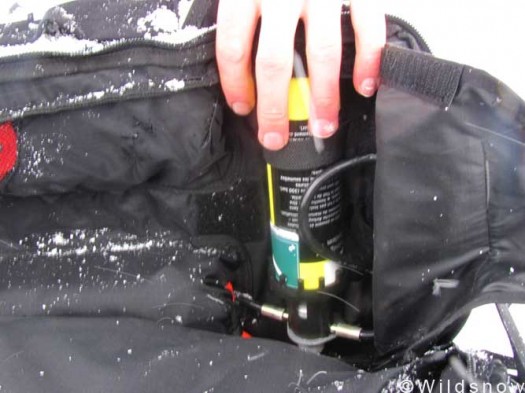
The cartridge is screwed into the puncture unit, all this sits behind a flap for protection and to keep it out of the way. I'm debating cutting it off, as the Powder base unit doesn't have one nor seem to need it.
15 L
The 15 liter zip on is a super small panel loader with a couple of external pockets. Like the Powder 15, it’s probably too small for true backcountry skiing, but could be perfect for dropping out the gate at the ski area. However, it’s heavier than the 18 liter, so I’m not sure why you would choose the 15. Perhaps if you want a pack with burlier fabric and extra features, such as an ice axe holder.

The main pocket has just a small horizontal zip opening which is hard to get into. Wish it were bigger and wrapped around down the sides. The front pocket is too small to fit even a small shovel or probe.
18 L Ultralight
Finally an airbag pack with a real attempt at saving weight. No extras, just a main compartment and a couple external zips. Yes, the base unit needs to be much lighter, but the zip on part is an example of the direction airbag packs need to go. The lightweight fabric may not be as durable as the other Vario zip ons, but that doesn’t matter for your average ski tour. Plus, it’s white which makes it easy to see inside it to find things and has a cool 10th Mountain camo feel. With a steel US cartridge (can we have a carbon cartridge in this country soon, please DOT?) and activation handle it weighs in at 7 pounds on my digital scale. Not the absolute lightest offering, but lighter than most of the airbag packs, and it has the interchangeable zip on feature. Of course, the zip on attachment system adds weight, but I think it’s more than worth it for the added utility.

To add more space, there is a mesh helmet attachment and a mesh gear pouch. The pouch will hold a helmet as well, so it's the one to use, and is shown here. The 15 zipon uses the same system.
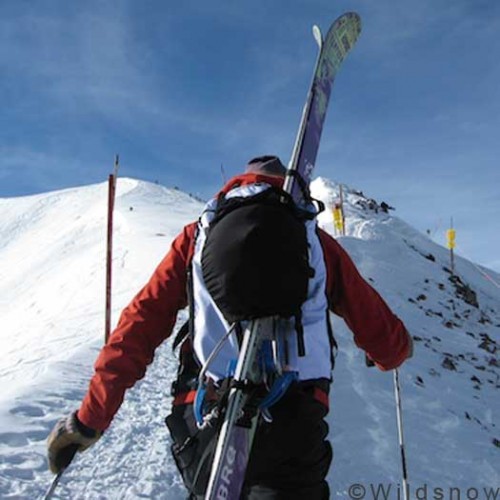
Diagonal ski carry with helmet attached with the mesh accessory. The skis carry comfortably, but the strap system is not ideal. A customized system would be easy to conjure up.
Not only is the 18 good for lightweight tours, but while in Telluride over the weekend, I found it to be the perfect ski area pack. It’s light enough that I can ski all day on the resort without taking it off, and if I drop out the gate from time to time during the day, I’m ready. Another thing I noticed while there was a relative abundance of these packs. In lower Bear Creek I ran into two different ABS pack users. Psyched to see people are beginning to use these things!

Inside the main compartment. The little black pouch is meant to hold the mesh helmet carrier, but I haven't bothered to use it.

I don't use a hydration system, but if you do, the 15 and 18 have a double zip system that allows you to run the hose out one side and unzip from the other side of the main compartment. Seems like an afterthought, but it works.
30 L
The 30 liter zip on has become my go to backcountry pack. It easily fits everything I care to bring, including more safety/emergency gear than I can fit in the 18 (bigger first aid kit, puffy pants, bivy sack, etc), and often with room to spare. It carries all this very comfortably and I hardly notice it compared to my older ABS Escape.

You can see the elastic running along the side edges of the lid, aggravating to use, but looks good closed.
It’s a toploader, and besides the main compartment, has an avy tool pocket up front and a lid with 2 zips (top and bottom). The top lid is sewed to the pack and the sides are elasticized, which can make it hard to flip the lid open off the top of the pack. However, it sits very snug when it is closed over the pack. I’d prefer a removable, floating lid and no elastic. Vertical zip access for the lid is unconventional and awkward to use. Perhaps it will train me from my habit of cramming too many things in the lid, as it’s frustrating to use when more than half full.

The front tool pocket will just fit a larger shovel such as this BD Bobcat, but I have to disassemble the handle into two parts. Regular sized shovels fit no problem.

If keeping yer tools in the main compartment is your thing, there is a velcroed sleeve against the back panel. A shovel blade in there wastes a lot of space though, so either put something else in there or get rid of it.

I'm convinced that I could get away with sewing ski straps on the reinforced black panels for A-frame ski carry. As you can see it doesn't appear to interfere with the air bags. Even though this pack carries skis diagonally well, I still hate diagonal ski carry.
50 L
The big one for overnights. This pack is basically the same as the 30, but everything is bigger, including the lid and pockets. The front tool pocket is so big that it could use organizer straps or cinches to keep things from clanging around. The Vario base unit is well padded and probably overkill for the lighter zip ons, but it pays off on the 50. ABS advertises two axe holders, but there is only one.

Fully loaded, except that I forgot to uncinch the lid (it can be shrunk down with a pair of straps).

The 50 can be compressed and with the lid removed isn't bad for a day pack while at your destination.
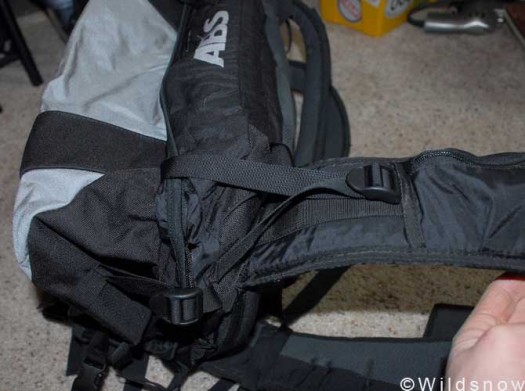
The Vario 50 is the only zip on with hip stabilizer straps, which attach to the base unit's hipbelt. These help pull the load to you body and onto your hips. Also, I should note that both the 50 and 30 have upper straps that are long enough to attach to the shoulder straps of the base unit to act as upper stabilizer straps.
In conclusion, the Vario system is an ingenious option for the air bag user who wants choices. In fact, if you don’t like any of the ABS zip ons, Rossignol, Dynastar, Arva, and Millet all offer their own zip on options that are compatible with the ABS base unit. And if you do like a particular zip on so much that you want to use it where there isn’t avalanche danger, such as in the summer, ABS sells a base unit without the airbag system. All this versatility comes at a small weight penalty. The current base unit and attachment system is beefy, so the bigger pack options (30 and 50) end up weighing in the 8 pound range with a filled steel cartridge, which is about average compared to the competition, but isn’t the lightest offering either. The 18 liter version is a pound lighter though, and with a carbon cartridge (due in the US anytime now) and next year’s lighter air bag material and workings, you could drop another pound. For a breakdown of the various options, see the airbag overview page, which has been updated with verified weights.
Oh, and if you’ve been wanting to see the footage from the first photo:
ABS Vario 30 Airbag Inflation from Nick Thompson on Vimeo.
Nick Thompson brings an incredible amount of skiing and mountaineering experience to WildSnow.com. Nick grew up climbing and skiing in the mecca of Telluride. He has a super attitude and incredible drive, making Nick one of those people who is terrific to be in the mountains with.

